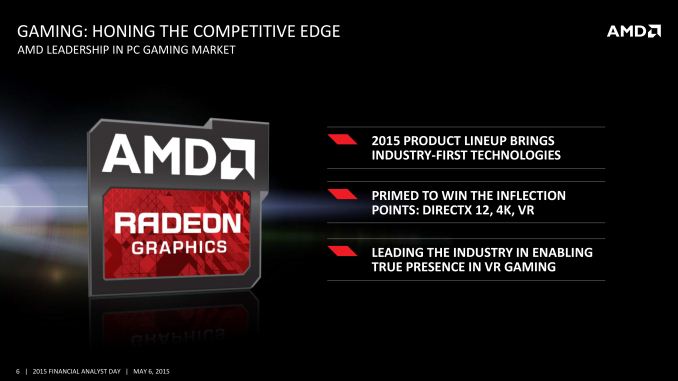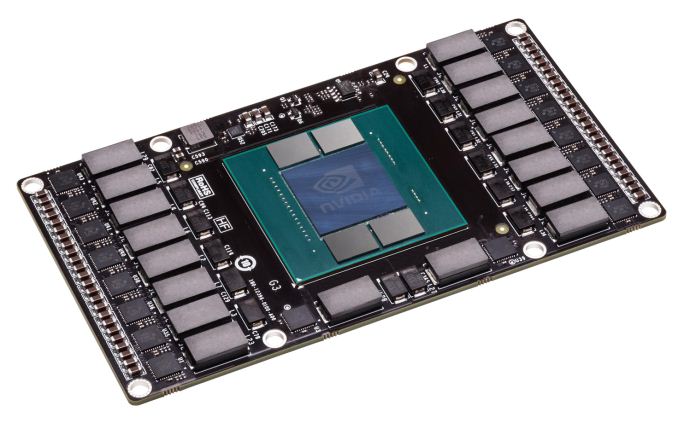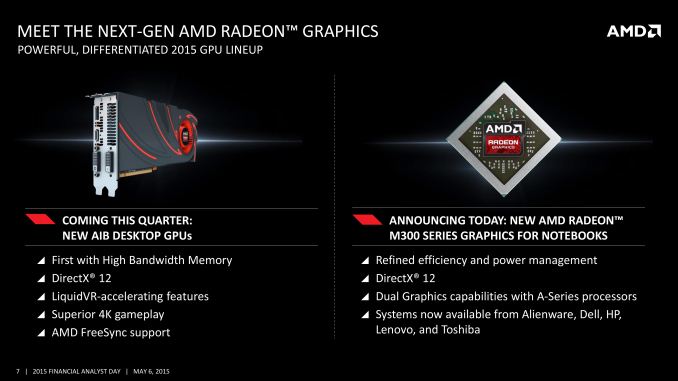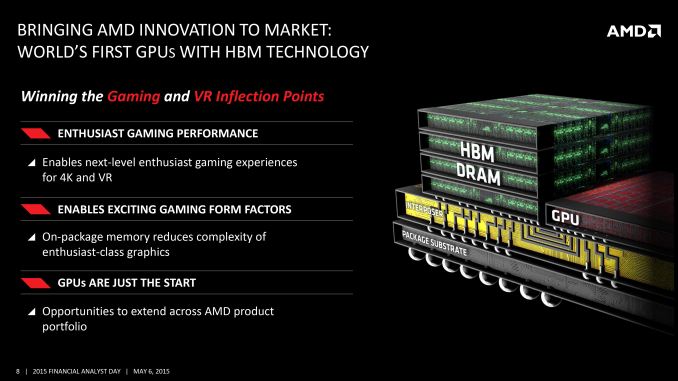AMD To Launch New Desktop GPU This Quarter (Q2’15) With HBM
by Ryan Smith on May 6, 2015 2:22 PM EST- Posted in
- GPUs
- AMD
- Radeon
- AMD FAD 2015

Having just left the stage at AMD’s financial analyst day is CEO Dr. Lisa Su, who was on stage to present an update on AMD’s computing and graphic business. As AMD has already previously discussed their technology roadmaps over the next two years earlier in this presentation, we’ll jump right into the new material.
Not mentioned in AMD’s GPU roadmap but now being mentioned by Dr. Su is confirmation that AMD will be launching new desktop GPUs this quarter. AMD is not saying much about these new products quite yet, though based on their description it does sound like we’re looking at high-performance products (and for anyone asking, the picture of the card is a placeholder; AMD doesn’t want to show any pictures of the real product quite yet). These new products will support DirectX 12, though I will caution against confusing that with Feature Level 12_x support until we know more.
Meanwhile the big news here is that these forthcoming GPUs will be the first AMD GPUs to support High Bandwidth Memory. AMD’s GPU roadmap coyly labels this as a 2016 technology, but in fact it is coming to GPUs in 2015. The advantage of going with HBM at this time is that it will allow AMD to greatly increase their memory bandwidth capabilities while bringing down power consumption. Coupled with the fact that any new GPU from AMD should also include AMD’s latest color compression technology, and the implication is that the effective increase in memory bandwidth should be quite large. For AMD, they see this as being one of the keys of delivering better 4K performance along with better VR performance.
In the process AMD has also confirmed that these HBM-equipped GPUs will allow them to experiment with new form factors. By placing the memory on the same package as the GPU, AMD will be able to save space and produce smaller cards, which will allow them to produce designs other than the traditional large 10”+ cards that are typical of high-end video cards. AMD competitor NVIDIA has been working on HBM as well and has already shown off a test vehicle for one such card design, so we have reason to expect that AMD will be capable of something similar.

With apologies to AMD: NVIDIA’s Pascal Test Vehicle, An Example Of A Smaller, Non-Traditional Video Card Design
Finally, while talking about HBM on GPUs, AMD is also strongly hinting that they intend to bring HBM to other products as well. Given their product portfolio, we consider this to be a pretty transparent hint that the company wants to build HBM-equipped APUs. AMD’s APUs have traditionally struggled to reach peak performance due to their lack of memory bandwidth – 128-bit DDR3 only goes so far – so HBM would be a natural extension to APUs.












146 Comments
View All Comments
chizow - Wednesday, May 13, 2015 - link
Not wanted by whom? AMD fanboys? LOL, onoes, I'm not going to call out AMD fanboys on their typical BS because it hurts their delicate fanboy sensibilities! Yeah. No.testbug00 - Thursday, May 7, 2015 - link
two articles about GPUs this year and the next. An article on K12 that might as well be integrated into the Zen/skybridge article. However, it is certainly not my site, it is run well. I assume there are reasons for doing things the way they are done! Thanks for the reply.rocketbuddha - Wednesday, May 6, 2015 - link
So MANTLE is no where to be found??Once again only DX-12.
Why not also add OGL Next aka VULCAN??
Refuge - Wednesday, May 6, 2015 - link
They already announced an end to Mantle, well not in those exact words... but same point yes.Senti - Wednesday, May 6, 2015 - link
No need to worry about Mantle – as Vulkan is effectively Mantle 2.0.I'm also irritated with DX12 hype, it's way too far from broad adoption.
Stahn Aileron - Wednesday, May 6, 2015 - link
Maybe so, but getting the hardware out in lockstep with the API is very useful. ATI did the same thing back in the day with DX9 and the old Radeon 9x00. Not many people like the idea of waiting on hardware releases to catch up with software. The same can be said vice versa, but getting software to match hardware is a LITTLE bit easier: software can be modded and released faster than implementing changes in hardware and getting those to the costumers. Future-proofed hardware isn't bad. If anything, getting the hardware out ahead of the API release means devs will actually start using the new API sooner rather than later.Krysto - Wednesday, May 6, 2015 - link
Not to mention DX12 only has half of the "new-era graphics API" features that Vulkan has. DX12 is more like Mantle 1.0 or Mantle 1.1.iniudan - Wednesday, May 6, 2015 - link
Mantle is only experimental now, it's still supported, but no point in mentioning it anymore.As for Vulcan it is still in development with an unknown release date, little point in mentioning it for Q2 product, as there likely no software release using it at least before Q4, as Valve likely the first one to will bring out something using it, as the Vulcan experimental Intel driver, the first driver with Vulcan support, was created by peoples subcontracted by Valve, so saying that Source 2 will be the first engine using Vulcan is a safe bet and we can estimate that Source 2 release is planned around SteamOS release, which is in Q4.
While we know that DirectX 12 is likely coming out in late Q2, along Windows 10 and the update of Xbox One to it.
Arizzle4l - Thursday, May 7, 2015 - link
AMD sites still shows mantle.http://www.amd.com/en-us/products/graphics/desktop...
extide - Wednesday, May 6, 2015 - link
Who says freesync can't do 144 hz? It can do any frequency the monitor supports, just someone has to release a monitor with a panel that supports those high rates..